ACURA RL 2011 Owner's Manual
Manufacturer: ACURA, Model Year: 2011, Model line: RL, Model: ACURA RL 2011Pages: 562, PDF Size: 11.41 MB
Page 21 of 562

See page f or how to adjust the
f ront seats.
If you sit too close to the steering
wheel or dashboard, you can be
seriously injured by an inf lating f ront
airbag, or by striking the steering
wheel or dashboard.
The National Highway Traffic Safety
Administration and Transport
Canada recommend that drivers
allow at least 10 inches (25 cm)
between the center of the steering
wheel and the chest. In addition to
adjusting the seat, you can adjust the
steering wheel up and down, and in
and out (see page ).
If you cannot get f ar enough away
f rom the steering wheel and still
reach the controls, we recommend
that you investigate whether some
type of adaptive equipment may help.
Adjust the driver’s seat as far to the
rear as possible while allowing you to
maintain f ull control of the vehicle.
Have a f ront passenger adjust their
seat as far to the rear as possible.
148
156
Protecting A dults and Teens
Adjust the Front Seats
2.
Driver and Passenger Saf ety
15
Sitting too close to a front
airbag can result in serious
injury or death if the front
airbags inflate.
Always sit as far back from the
front airbags as possible.
10/08/04 18:43:17 31SJA660_020
ProCarManuals.com
Page 22 of 562
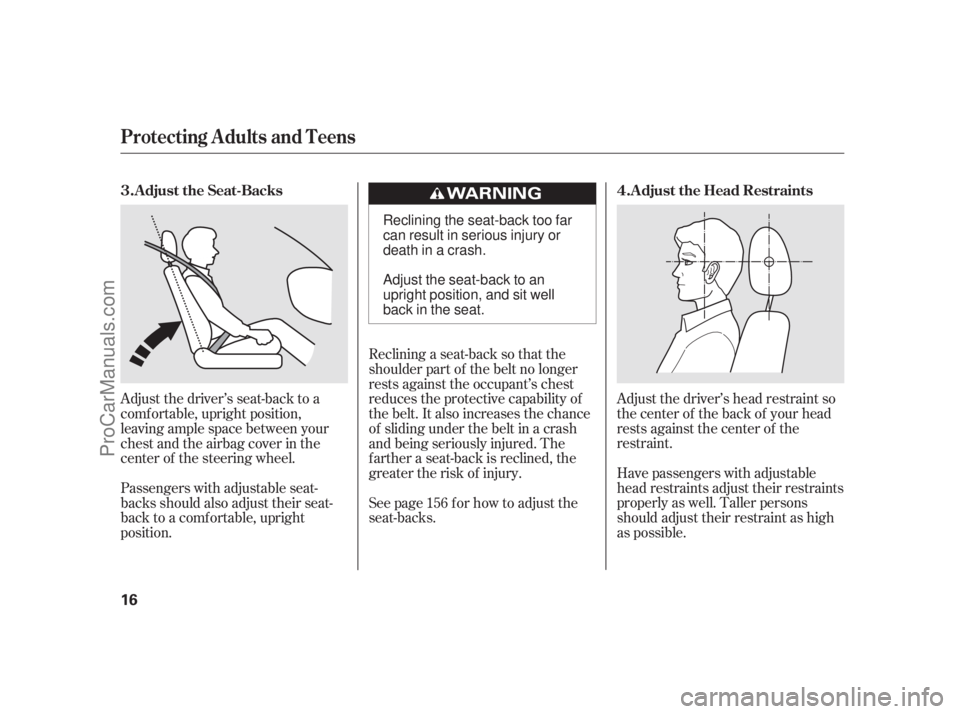
Adjust the driver’s head restraint so
the center of the back of your head
rests against the center of the
restraint.
Have passengers with adjustable
head restraints adjust their restraints
properly as well. Taller persons
should adjust their restraint as high
as possible.
Reclining a seat-back so that the
shoulder part of the belt no longer
rests against the occupant’s chest
reduces the protective capability of
the belt. It also increases the chance
of sliding under the belt in a crash
and being seriously injured. The
farther a seat-back is reclined, the
greater the risk of injury.
See page f or how to adjust the
seat-backs.
Adjust the driver’s seat-back to a
comf ortable, upright position,
leaving ample space between your
chest and the airbag cover in the
center of the steering wheel.
Passengers with adjustable seat-
backs should also adjust their seat-
back to a comf ortable, upright
position.
156
Protecting A dults and Teens
A djust the Head Restraints
Adjust the Seat-Backs 4.
3.
16
Reclining the seat-back too far
can result in serious injury or
death in a crash.
Adjust the seat-back to an
upright position, and sit well
back in the seat.
10/08/04 18:43:29 31SJA660_021
ProCarManuals.com
Page 23 of 562
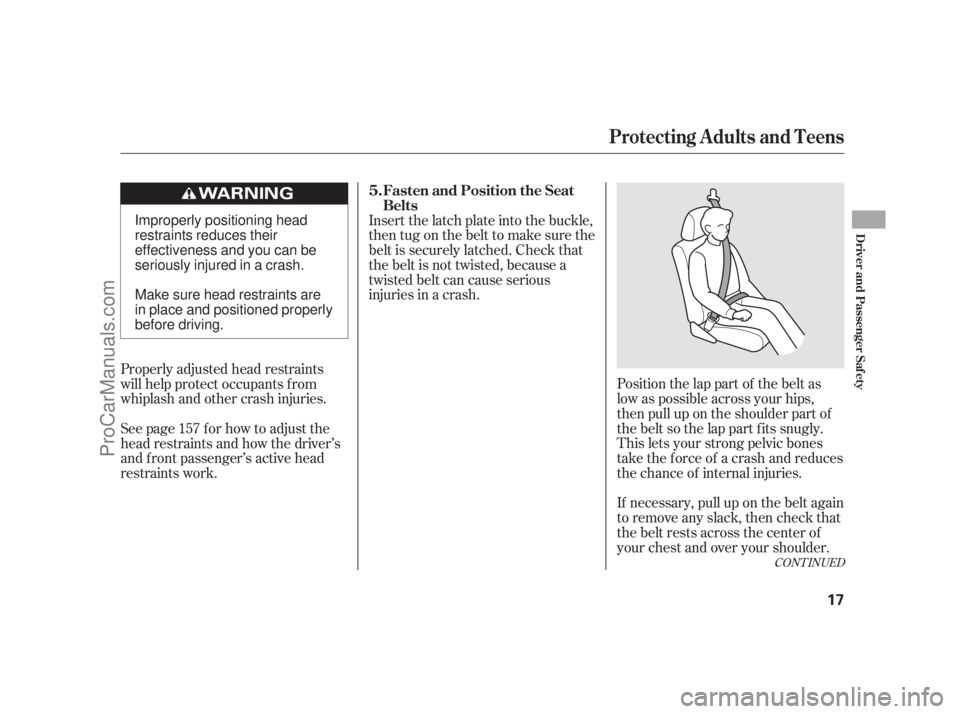
CONT INUED
Position the lap part of the belt as
low as possible across your hips,
then pull up on the shoulder part of
the belt so the lap part f its snugly.
This lets your strong pelvic bones
take the force of a crash and reduces
the chance of internal injuries.
If necessary, pull up on the belt again
to remove any slack, then check that
the belt rests across the center of
your chest and over your shoulder.
Insert the latch plate into the buckle,
then tug on the belt to make sure the
belt is securely latched. Check that
the belt is not twisted, because a
twisted belt can cause serious
injuries in a crash.
Properly adjusted head restraints
will help protect occupants f rom
whiplash and other crash injuries.
See page f or how to adjust the
head restraints and how the driver’s
and f ront passenger’s active head
restraints work. 157
Protecting A dults and Teens
Fasten and Position the Seat
Belts
5.
Driver and Passenger Saf ety
17
Improperly positioning head
restraints reduces their
effectiveness and you can be
seriously injured in a crash.
Make sure head restraints are
in place and positioned properly
before driving.
10/08/04 18:43:39 31SJA660_022
ProCarManuals.com
Page 24 of 562
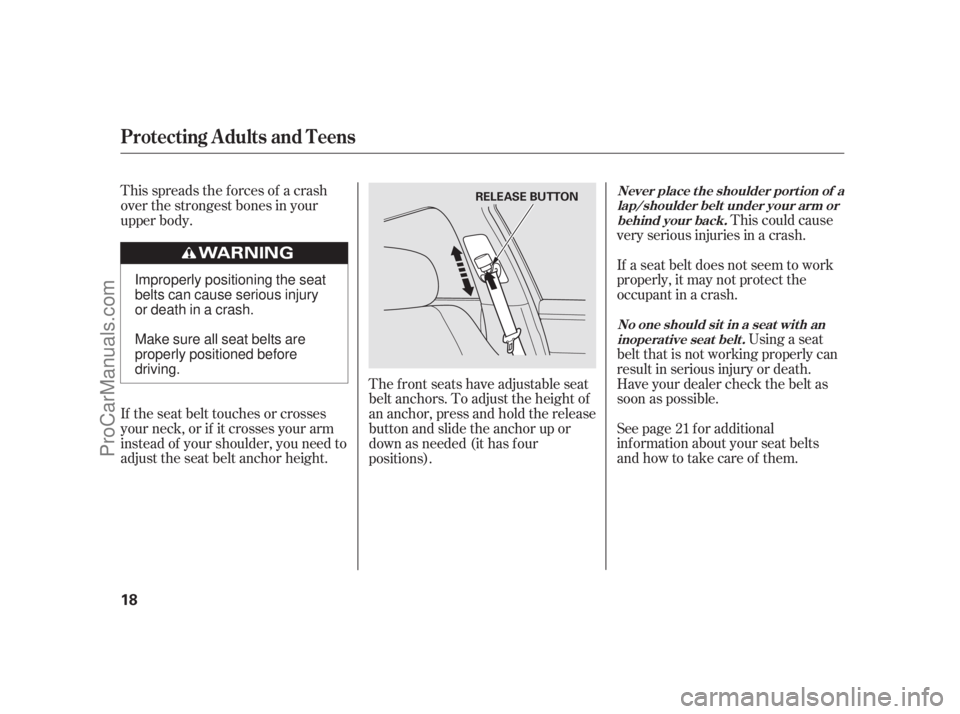
This could cause
very serious injuries in a crash.
If a seat belt does not seem to work
properly, it may not protect the
occupant in a crash.
Using a seat
belt that is not working properly can
result in serious injury or death.
Have your dealer check the belt as
soon as possible.
See page f or additional
inf ormation about your seat belts
and how to take care of them.
If the seat belt touches or crosses
your neck, or if it crosses your arm
instead of your shoulder, you need to
adjust the seat belt anchor height. This spreads the f orces of a crash
over the strongest bones in your
upper body.
The front seats have adjustable seat
belt anchors. To adjust the height of
an anchor, press and hold the release
button and slide the anchor up or
down as needed (it has f our
positions). 21
Protecting A dults and Teens
Never place t he shoulder port ion of a
lap/shoulder belt under your arm orbehind your back.
No one should sit in a seat wit h aninoperat ive seat belt .
18
RELEASE BUTTON
Improperly positioning the seat
belts can cause serious injury
or death in a crash.
Make sure all seat belts are
properly positioned before
driving.
10/09/08 21:18:16 31SJA660_023
ProCarManuals.com
Page 25 of 562

If you are pregnant, the best way to
protect yourself and your unborn
child when driving or riding in a
vehicle is to always wear a seat belt,
and keep the lap part of the belt as
low as possible across the hips.
In addition, an occupant who is out of
position in the f ront seat can be
seriously or f atally injured in a crash
by striking interior parts of the
vehicle or being struck by an
inflating front airbag.
After all occupants have adjusted
their seats and head restraints, and
put on their seat belts, it is very
important that they continue to sit
upright, well back in their seats, with
their feet on the floor, until the
vehicle is safely parked and the
engine is of f .
Sitting improperly can increase the
chance of injury during a crash. For
example, if an occupant slouches,
lies down, turns sideways, sits
forward, leans forward or sideways,
or puts one or both f eet up, the
chance of injury during a crash is
greatly increased.
CONT INUED
Protecting A dults and Teens
Advice f or Pregnant Women
Maintain a Proper Sitting
Position
6.
Driver and Passenger Saf ety
19
Sitting improperly or out of
position can result in serious
injury or death in a crash.
Always sit upright, well back in
the seat, with your feet on the
floor.
10/08/04 18:43:59 31SJA660_024
ProCarManuals.com
Page 26 of 562

When driving, remember to sit
upright and adjust the seat as f ar
back as possible while allowing f ull
control of the vehicle. When riding
as a f ront passenger, adjust the seat
as far back as possible.
This will reduce the risk of injuries
to both you and your unborn child
that can be caused by a crash or an
inflating front airbag.
Each time you have a checkup, ask
your doctor if it’s okay f or you to
drive.If they do, they
could be very seriously injured in a
crash. Devices intended to improve
occupant comf ort or reposition the
shoulder part of a seat belt can
reduce the protective capability of
thebeltandincreasethechanceof
serious injury in a crash.
Carrying hard or sharp
objects on your lap, or driving with
a pipe or other sharp object in
your mouth, can result in injuries
if your f ront airbag inf lates.
If your
hands or arms are close to an
airbag cover, they could be injured
if the airbag inf lates. Objects on
the covers marked ‘‘SRS AIRBAG’’
could interf ere with the proper
operation of the airbags or be
propelled inside the vehicle and
hurt someone if the airbags inf late.
If a side airbag or a
side curtain airbag inf lates, a cup
holder or other hard object
attached on or near the door could
be propelled inside the vehicle and
hurt someone.
Improperly replacing
or covering f ront seat-back covers
can prevent your side airbags f rom
inf lating during a side impact.
Protecting A dults and Teens
Additional Saf ety Precautions
T wo people should never use t he
same seat belt . Do not put any accessories on seat
belts.
Do not place hard or sharp object sbet ween yourself and a f rontairbag.
K eep your hands and arms awayf rom t he airbag covers. Do not at t ach or place object s on
the f ront airbag covers.
Do not at t ach hard object s on ornear a door.
Do not cover or replace f ront seat -back covers wit hout consult ingyour dealer.
20
10/08/04 18:44:10 31SJA660_025
ProCarManuals.com
Page 27 of 562

CONT INUED
Your seat belt system includes lap/
shoulder belts in all seating positions.
The f ront seat belts are also
equipped with automatic seat belt
tensioners and, on models with
collision mitigation braking system
(CMBS ), seat belt e-pretensioners.The seat belt system
includes an indicator on the
instrument panel and a beeper to
remind you and your passengers to
f asten your seat belts.
This system monitors the f ront seat
belts. If you turn the ignition switch
to the ON (II) position bef ore your
seat belt is f astened, the beeper will
sound and the indicator will f lash. If
your seat belt is not f astened bef ore
the beeper stops, the indicator will
stop f lashing but remain on.
If a f ront passenger does not f asten
their seat belt, the indicator will
come on about 6 seconds af ter the
ignition switch is turned to the ON
(II) position. You will also see a ‘‘FASTEN SEAT
BELT’’ or ‘‘FASTEN PASSENGER
SEAT BELT’’ message on the multi-
inf ormation display (see page ).
When no one is sitting in the f ront
passenger’s seat, or a child or small
adult is riding there, the indicator
should not come on and the beeper
should not sound. If either the driver or a f ront
passenger does not f asten their seat
belt while driving, the beeper will
sound and the indicator will f lash
again at regular intervals.
62
Seat Belt System Components
Additional Inf ormation About Your Seat Belts
Driver and Passenger Saf ety
21
TM
TM
10/08/04 18:44:21 31SJA660_026
ProCarManuals.com
Page 28 of 562
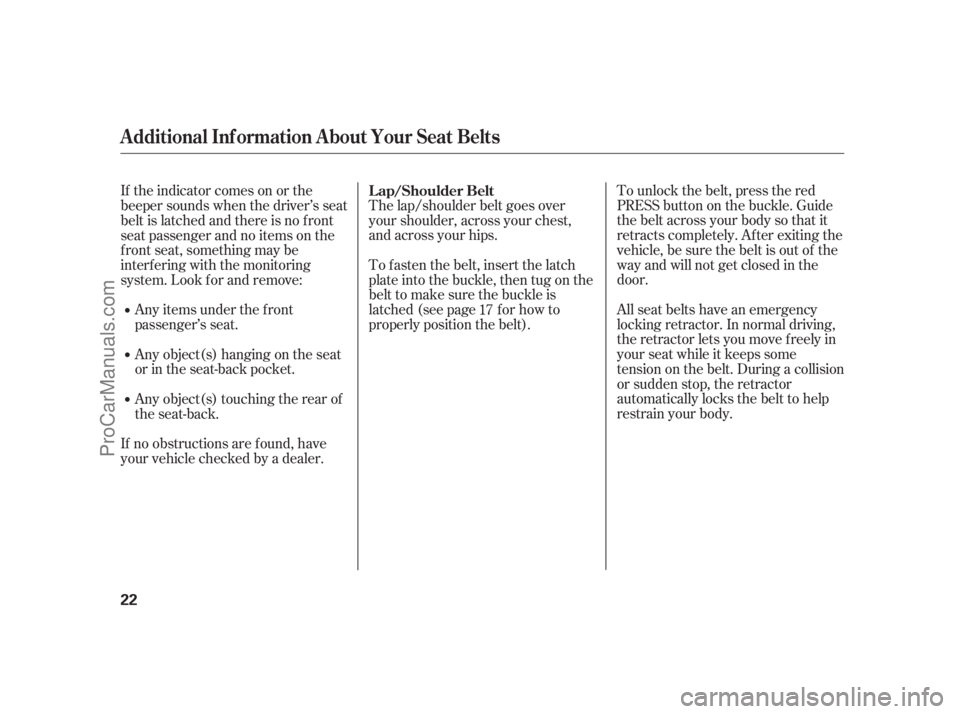
To unlock the belt, press the red
PRESSbuttononthebuckle.Guide
the belt across your body so that it
retracts completely. Af ter exiting the
vehicle, be sure the belt is out of the
way and will not get closed in the
door.
All seat belts have an emergency
locking retractor. In normal driving,
the retractor lets you move f reely in
your seat while it keeps some
tension on the belt. During a collision
or sudden stop, the retractor
automatically locks the belt to help
restrain your body.
The lap/shoulder belt goes over
your shoulder, across your chest,
and across your hips.
To fasten the belt, insert the latch
plate into the buckle, then tug on the
belt to make sure the buckle is
latched (see page f or how to
properly position the belt).
If the indicator comes on or the
beeper sounds when the driver’s seat
belt is latched and there is no f ront
seat passenger and no items on the
front seat, something may be
interf ering with the monitoring
system. Look f or and remove:
Any items under the f ront
passenger’s seat.
Any object(s) hanging on the seat
or in the seat-back pocket.
Any object(s) touching the rear of
the seat-back.
If no obstructions are f ound, have
your vehicle checked by a dealer. 17
L ap/Shoulder Belt
Additional Inf ormation About Your Seat Belts
22
10/08/04 18:44:32 31SJA660_027
ProCarManuals.com
Page 29 of 562
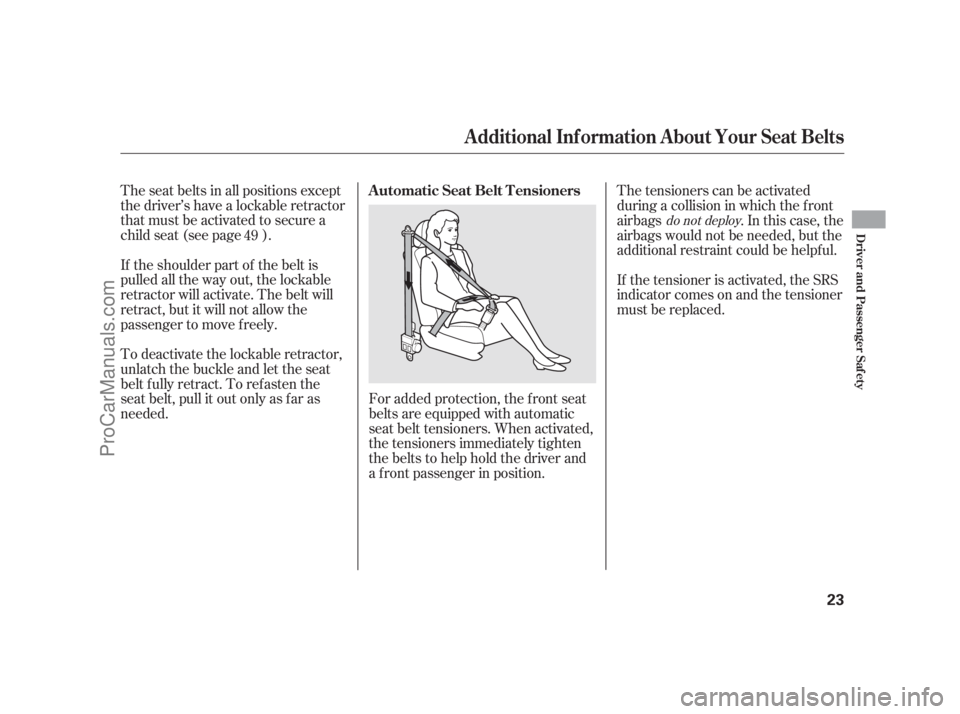
For added protection, the f ront seat
belts are equipped with automatic
seat belt tensioners. When activated,
the tensioners immediately tighten
the belts to help hold the driver and
a f ront passenger in position.
The seat belts in all positions except
the driver’s have a lockable retractor
that must be activated to secure a
child seat (see page ).
If the shoulder part of the belt is
pulled all the way out, the lockable
retractor will activate. The belt will
retract, but it will not allow the
passenger to move f reely.
To deactivate the lockable retractor,
unlatch the buckle and let the seat
belt fully retract. To refasten the
seat belt, pull it out only as f ar as
needed.
The tensioners can be activated
during a collision in which the f ront
airbags . In this case, the
airbags would not be needed, but the
additional restraint could be helpf ul.
If the tensioner is activated, the SRS
indicator comes on and the tensioner
must be replaced.
49
do not deploy
A utomatic Seat Belt T ensioners
Additional Inf ormation About Your Seat Belts
Driver and Passenger Saf ety
23
10/08/04 18:44:42 31SJA660_028
ProCarManuals.com
Page 30 of 562

For added saf ety, the f ront seat belts
are equipped with e-pretensioners
that work in combination with the
collision mitigation braking system
(CMBS ) (see page ) and the
brake pedal assist f unction (see page). If your vehicle gets too close to the
vehicle ahead of it in your lane, the
driver’s e-pretensioner slightly
retracts the seat belt to alert the
driver of the approaching vehicle. If
a collision with the vehicle in f ront of
you is likely, the e-pretensioners on
both front seats retract the seat belts
with enough f orce to properly
restrain you and your f ront
passenger. After they activate, the
e-pretensioners release the retracted
seat belts.
To get the f ull benef it of the
e-pretensioners, you and your f ront
passenger must sit normally in your
seats and wear your seat belts
properly (see page ).
The e-pretensioners do not activate
when the vehicle stability assist
(VSA) of f indicator on the
instrument panel is on.
If the automatic seat belt tensioners
are activated by a collision, both
f ront seat belts and all related
components must be replaced (see
page ). If only the
e-pretensioners were activated, no
components need to be replaced.
In addition, the f ront passenger’s
e-pretensioner does not activate
when the passenger’s airbag is
automatically turned off because the
weight sensor detects a child in the
f ront passenger’s seat.
17
415 418 25
On models with Collision Mitigation
Braking System
Seat Belt e-pretensioners
Additional Inf ormation About Your Seat Belts
24
TM
TM
10/08/04 18:44:52 31SJA660_029
ProCarManuals.com